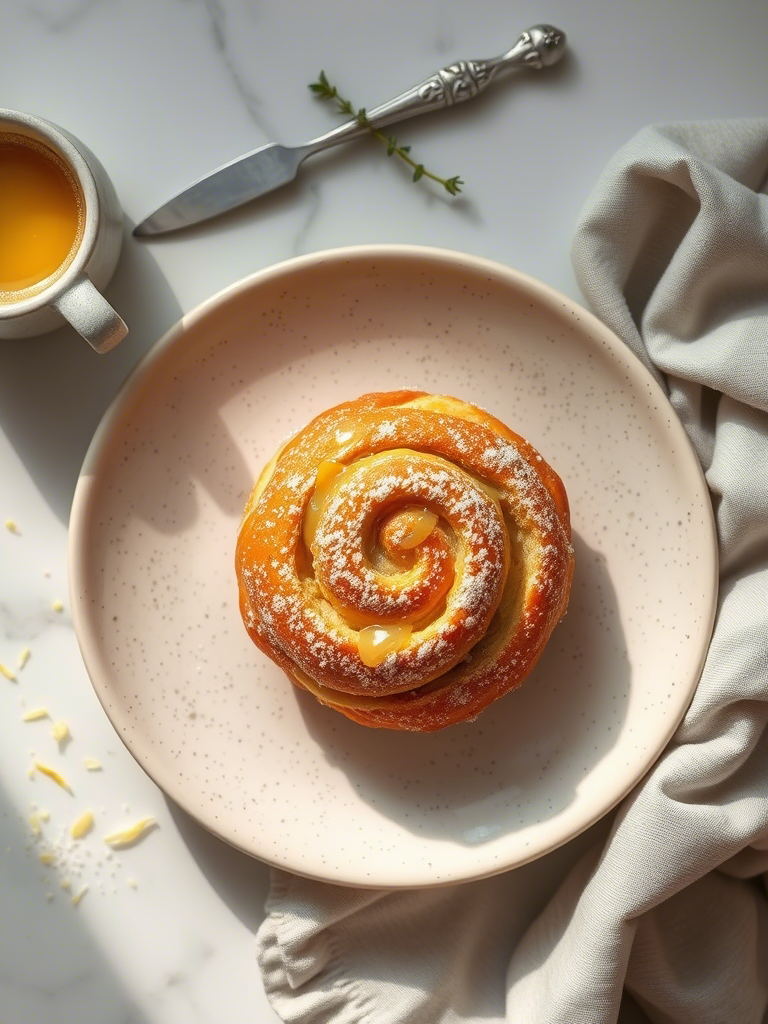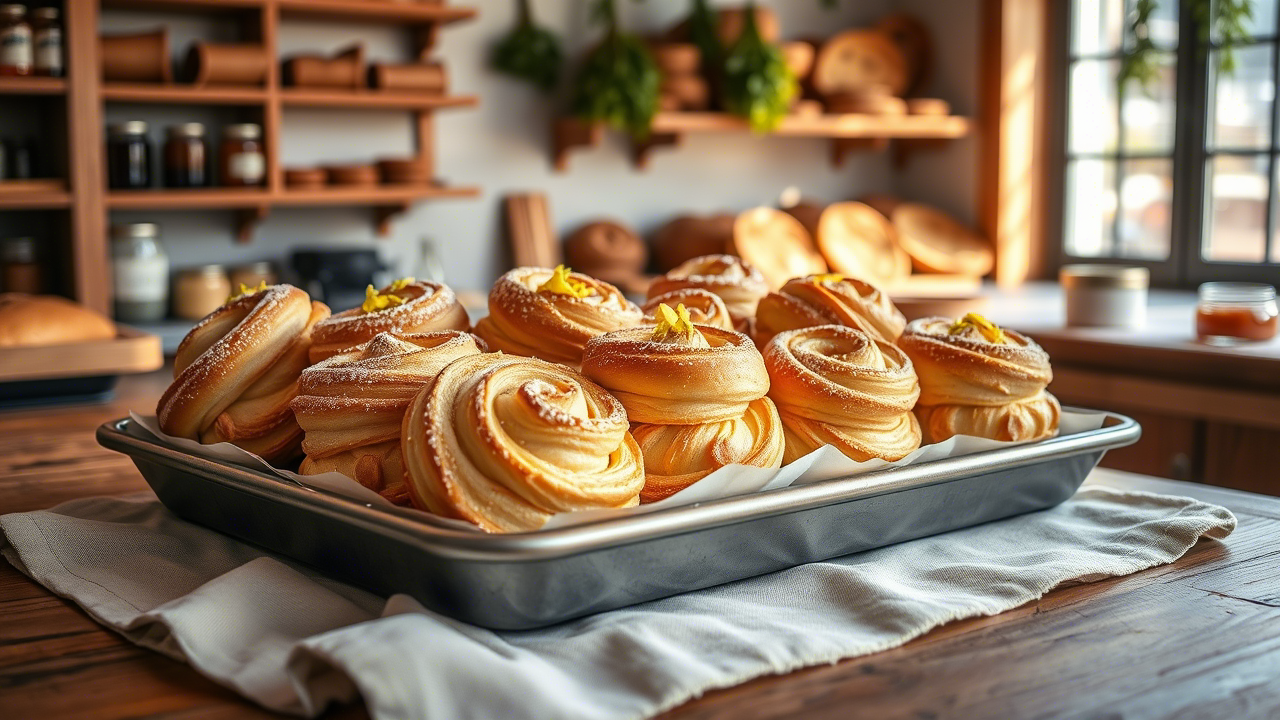You ever bite into something so good it stops your whole day? That’s a cruffin. Half croissant, half muffin, this hybrid pastry is flaky, buttery, tall, and just barely holding it together—kinda like most of us before coffee. But don’t let its Instagrammable looks fool you. This isn’t just a gimmick. It’s technical, it’s challenging, and when done right, it’s borderline genius.
In this deep dive, we’ll unpack everything from the science of laminated dough to why bakeries charge $6.50 a pop for one. Whether you’re a professional pastry chef, a bakery owner, or just pastry-curious, this guide’ll give you the real, rich lowdown.
What Is a Cruffin, Really?
It’s not just a croissant in a muffin tin.
A cruffin starts with laminated croissant dough, rolled and shaped into tall, spiral towers, baked in muffin molds. Once baked, they’re filled with custards, jams, or creams—and dusted with sugar, always sugar. It’s got the structure of a muffin, the lamination of a croissant, and the creativity of a dessert tasting menu. Kinda brilliant, if you ask me.
The term “cruffin” was reportedly trademarked by Mr. Holmes Bakehouse in San Francisco back in 2013, though like most food inventions, folks were probably making versions of it before that too. Now, cruffins have popped up in bakeries from Melbourne to Paris to Brooklyn.
Why Pastry Pros Are Obsessed with Cruffins
Let’s be honest—croissants are hard. Muffins? Easy. Cruffins? Somewhere in that wild, flaky middle.
Bakers love cruffins because they allow for expression without reinventing the lamination wheel. You can take your standard croissant base and just play: cinnamon-sugar, raspberry-rose, lemon-thyme cream… heck, I’ve seen bacon-maple ones fly off shelves faster than you can say, “cardiac arrest.”
And for bakeries, they’re a profit powerhouse. One batch of croissant dough, and you’ve got a dozen SKUs. The margin on these things? Chef’s kiss. Plus, they photograph beautifully, which feeds the beast that is food marketing.
The Lamination: Not for the Faint of Whisk
Okay, buckle in.
Lamination is the backbone of a cruffin. You’re taking dough and butter, and layering them—over and over again—to create micro-thin pockets of fat and flour. When it hits heat, steam forms and gives those signature flaky layers.
For pros, consistency is everything. If your butter’s too cold, it’ll shatter. Too warm? It leaks. And you will cry.
Here’s a quick rundown of the critical points:
- Use high-fat European butter (like Plugrá or Président) for pliability.
- Dough needs rest. A good 30 minutes between folds—don’t rush it.
- Final roll-out should be precise. Around 3mm thick.
- Roll it tight. Not like a yoga mat, more like a jelly roll that went to pastry school.

Shaping Secrets: From Dough to Muffin Mold
This is where the muffin comes in. Literally.
Once your laminated dough is rolled and chilled, you cut it into strips—usually about 1.5″ wide. Each strip is coiled into a spiral, like a cinnamon roll’s ambitious cousin. Then it’s set vertically in a well-buttered muffin tin.
Pro tip? Let ‘em proof slowly. Overnight in the fridge if you can. A quick proof gives you dense centers and uneven rise. Slow proof? Silky insides, crispy outsides, and the kind of oven spring that makes you high-five the air.
And grease those tins like you’re trying to slide down them. Cruffins will stick, and there’s no sadder sight than a ripped pastry.
Fillings: Where the Real Magic Happens
A naked cruffin is a beautiful thing—but let’s not pretend people aren’t here for the gooey stuff inside.
The filling options are where artistry shows. Vanilla bean pastry cream. Raspberry coulis. Nutella ganache. I’ve even had one filled with Thai tea custard that changed my whole perspective on life for, like, three minutes.
Best practices?
- Pipe after baking. Always.
- Use a Bismarck tip for accuracy.
- Don’t overfill. Just enough for a surprise, not a flood.
And finish with flair—dusting sugar, cinnamon, freeze-dried fruit powder, crushed pistachios. Anything that crunches or sparkles is a win.
Real-World Case Study: London’s “Cruffin Rush”
In 2021, London bakery Dominique’s Lab saw a 220% spike in cruffin sales after a single TikTok went viral. They had to cap daily quantities, and folks were lining up at 6am.
It wasn’t just the visual appeal. Their flavor calendar changed weekly. Think: elderflower lemon, chai-latte, dark chocolate espresso.
This agile, flavor-forward approach built hype. More importantly, it kept loyal customers coming back just to see what’s new.
Common Cruffin Mistakes (That Even Pros Make)
Let’s talk blunders.
- Underproofing. This one’s rampant. Cruffins need time to relax and rise. If you bake them too soon, the butter leaks and you get soggy-bottom sadness.
- Overbaking. A lot of ovens run hot. 375°F (190°C) is usually perfect, but keep an eye out at the 20-minute mark.
- Forgetting the sugar coating. Seems small, but that roll in sugar while still warm? That’s textural gold.
And please—don’t cheap out on ingredients. A good cruffin isn’t hiding behind filler flavors. It is the flavor.
Ingredient Spotlight: Why Flour Type Matters
You’d think all-purpose flour works, right? Eh. Not always.
For best lamination, you want a medium protein content. Around 11-12%. Too low, and your layers collapse. Too high, and it gets chewy, not flaky.
Pastry chefs often blend pastry flour with a bit of bread flour. It’s a delicate balance—like jazz, but with gluten.
Scaling Cruffins for Commercial Kitchens
Batching cruffins in a home kitchen is one thing. But commercial operations? Whole other beast.
Here’s what needs attention:
- Walk-in fridge temps. Lamination hates humidity. A controlled dough room is gold.
- Timing. You can prep the dough a day ahead, shape the next day, bake third. Or stagger. But it must be cold when shaping.
- Storage. Cruffins have a 24-hour window of glory. After that? Still edible, but the crisp dies.
Vacuum-sealing or blast-chilling filled cruffins for next-day service is tricky, but some shops make it work with airtight containers and warm-up protocols.

Emerging Trends in Cruffin Craft
Things are getting wild.
- Savory cruffins. Think prosciutto, truffle béchamel, or sundried tomato pesto. Served warm. With a wine pairing? Oh yes.
- Seasonal limited drops. Pumpkin spice in fall. Peppermint mocha in winter. Mango lassi for summer. Adds urgency to your product lineup.
- Mini cruffins. Bite-sized versions for catering or high-tea trays. High yield, high wow.
Another cool move? Letting customers build their own cruffin. Like frozen yogurt, but with butter.
Expert Insight: What the Pros Say
Chef André Caron of Montréal’s famed “Le Petit Four” says,
“Cruffins are a canvas. They let you speak in layers. You can make someone remember their childhood or surprise them with something they’ve never tasted.”
That’s the charm. A good cruffin doesn’t just feed—it tells stories.
Frequently Asked Questions
Can I freeze cruffins?
Unbaked cruffin dough? Yes. Freeze after shaping, then bake from frozen. Add 5–10 mins to bake time.
Baked and filled cruffins? Not ideal. Texture suffers.
Why do my cruffins collapse after baking?
They’re either underproofed or overbaked. Also, check your oven temp. Too high = outside browns before inside sets.
Do I need a stand mixer for the dough?
Yes, unless your arms are made of titanium. You need smooth, elastic dough with strong gluten development. Hand-kneading works, but it’s a workout.
Final Thoughts: The Future of Cruffins
Cruffins aren’t just a trend. They’re a testament to what happens when technique meets creativity.
They challenge bakers to be both disciplined and imaginative. They invite customers to explore beyond a plain croissant or muffin. And they’re just plain fun to eat. Ridiculously fun.
So if you haven’t tried making them yet—what are you waiting for? And if you’re already cruffin-famous, maybe it’s time to level up. Add that sesame-miso caramel. That blood orange curd. That moment of madness people’ll talk about all week.
Because let’s be honest. Life’s too short for boring pastries.

Mariana is a passionate home cook who creates delicious, easy-to-follow recipes for busy people. From energizing breakfasts to satisfying dinners and indulgent desserts, her dishes are designed to fuel both your body and hustle.
When she’s not in the kitchen, she’s exploring new flavors and dreaming up her next recipe to share with the Foodie Hustle community.

